1. The buffer underrun eliminator!
Sanyo CRD-BP2
SCSI CDR-W - Page 1
The buffer underrun eliminator!
 Most
users are aware of the Sanyo name as a prominent consumer appliances, electronics,
and home entertainment device manufacturer. Few, if any, know as well that Sanyo
is among the biggest CDR pick-up (and supporting chipset) makers. In particular,
many current 8- and higher-speed CD recorder drives are based on laser diodes
produced by Sanyo.
Most
users are aware of the Sanyo name as a prominent consumer appliances, electronics,
and home entertainment device manufacturer. Few, if any, know as well that Sanyo
is among the biggest CDR pick-up (and supporting chipset) makers. In particular,
many current 8- and higher-speed CD recorder drives are based on laser diodes
produced by Sanyo.
It is the laser diode that determines to a large extend the maximum
recording and re-writing speed of a particular drive and its reliability, roughly
measured as the average hours of CD recording until the diode failures. Much
to their users' dissatisfaction, most first and second generation drives suffered
from early diodes malfunctions and eventually disintegration. The latest supporting
components offered by Sanyo to various CD recorder makers have well established
it as a reliable and credible manufacturer.
One of the major shortcomings of current CD recorder technology,
the one that particularly has prevented most average users from enjoying the
use of a CD recorder drive into their home PCs, is the frequent destruction
of their media during recording. This is mainly due to the inadequacy of the
PC to keep-up with the bus data demand during recording and is usually termed
buffer underrun.
 Being the first CDR maker to offer 12x recording speeds on its drives, Sanyo
this time innovated once more and moved CD recording technology one step further
into the future. It recently developed and introduced a new revolutionary achievement
that eliminates buffer underruns, equipping its latest pick-up offering with
the so-called "BURN-Proof" feature. Does this new technology work
as well as the Sanyo specifications claim? What does it offer to all of us?
Being the first CDR maker to offer 12x recording speeds on its drives, Sanyo
this time innovated once more and moved CD recording technology one step further
into the future. It recently developed and introduced a new revolutionary achievement
that eliminates buffer underruns, equipping its latest pick-up offering with
the so-called "BURN-Proof" feature. Does this new technology work
as well as the Sanyo specifications claim? What does it offer to all of us?
Introduction :
As it might be known, Sanyo is the company behind many current 8x CDR-W
drives. It debuted with an 8x writer (the 8/20 model), after which a series
of high speed writers followed: a 8x writer with re-write capability (8/2/20),
a 8x writer with a 4x re-write speed and finally its worldwide first, the first
12x writer which was also a 4x re-writer. Its very latest recorder also includes
the so-called BURN-Proof feature, which eliminates the main cause that leads
to badly burned disks (also known as coasters).
The achievement of 12x recording speed is by no means trivial.
As the times of following table show, it transforms a CD recorder to a giant
floppy disk drive with the performance of almost a hard disk!
|
Recording Speeds and Times
|
|
74 mins / 650 mb
|
1x
|
74 mins
|
|
74 mins / 650 mb
|
2x
|
37 mins
|
|
74 mins / 650 mb
|
4x
|
18.5 mins
|
|
74 mins / 650 mb
|
6x
|
12.34 mins
|
|
74 mins / 650 mb
|
8x
|
9.25 mins
|
|
74 mins / 650 mb
|
12x
|
6.17 mins
|
History
Buffer underrun errors have been proven to be the largest annoyance for the
users of CD-R/RW drives since the very beginning of CD recording history. For
the time being, BURN-Proof seems to be the only available technology, which
seems to protect recording media from this type of errors.
A CD-R/RW drive records data on a disc at a Constant Linear Velocity
(CLV). Once the drive starts to record, the host computer has to send data to
the drive at a rate at least equal to the speed of writing. For example, in
the case of a 12x speed recording, the expected data rate is 2352x75x12 bytes
per second, or approximately 2Mbytes/sec. This is because 1 block is 2352bytes,
1 second is 75 blocks and the recording occurs at 12x speed, and this indeed
imposes a heavy tax on system resources during burning. As most operating systems
in wide use today are not specifically designed for streaming high volume data
in real time, the data transfer rate of a PC over the peripheral bus is not
stable.
This is due to variations of a PC's job-load, the occasional
misbehavior of working applications and (some times) due to the idiosyncrasies
(and/or inadequacies) of the underlying operating system (in our case any Windows
flavour). Therefore, the CD-R/RW drive has to store at first a certain amount
of data derived from the PC into a dedicated memory, called a buffer. This buffer
is used for taking care off even the slightest differences between the CLV drive
recording speed and the unstable data flow from the PC. For reasons of space,
in the following we interchangeable use the term "data" both for recording
regular data as well as audio files.
Why the BufferUnderRun occurs?
Under any normal situation the drive buffer should always be able to maintain
enough data needed for recording onto the inserted media at a pre-specified
speed. In an ideal case, the drive itself should have a 650MB capacity buffer,
which is obviously unrealistic. In practice, the buffer memory of most current
recorder drives is usually 2-4Mbytes. Of course, a buffer underrun error can
never occur when the drive records data of a total capacity less than or equal
to the buffer size. (For example, this happens when performing "packet"
recording, i.e., when the data is written in small "chunks").
In all other cases there is a constant need in part of the drive
for receiving enough data from the host PC throughout the whole recording process.
Consequently, when the streaming data is delayed beyond a certain point, the
drive cannot continue the recording procedure due to the exhaustion of the buffer
in data. This type of recording error is usually termed as a "Buffer Under
Run Error".
How it is implement in CDR-W drive?
For a CDR-W drive to support the BURN-Proof feature it must make use of
a special LSI (Large Scale Integration) chipset. In the case of the CRD-BP2
reviewed here, the supporting chips are the SANYO LC898023K and LC898093K. Although
CDR is a digital technology, as in almost all cases where mass storage media
are concerned, the actual signals are recorded on a disk as analogue.
The above mentioned LSI chips have the capability of controlling
these analogue signals to suspend and restart recording. Both chips contain
proprietary "microcode" developed by SANYO. In order for the BURN-Proof
technology to work the respective CDR Software used for recording must also
be BURN-Proof compatible. For now, only Nero Burning Rom, NTI CD-Maker pro and
Bs Recorder Gold (in Japanese) are supported. Recently, DiscJuggler introduced
a BURN-Proof enabled version, but it still suffers from beta-software problems
(doens't work at all..)
Where does BURN-Proof name come from?
From Buffer Under RuN-Proof.
How Burn Proof Drives avoids Buffer Under Run Error?
Immediately
after the recording starts, the micro-controller inside the CD-R/RW drive
always monitors the status of the buffer. When the drive judges that a Buffer
Underrun Error is about to happen, it suspends recording at the appropriate
location of the EFM (Eight-to-Fourteen Modulation) pattern.
While the drive stays in suspend mode, it continues trying to
receive data from the host PC to fill-up its data buffer and subsequently prepares
itself to restart recording by accessing the end of the previously recorded
area (EFM pattern). To continue recording at the appropriate place, the drive
compares the recorded data with the data in buffer for synchronizing adjacent
frames. Afterwards, it restarts recording as soon as it exactly locates the
last recorded point. Because the micro-controller in the drive stores the suspended
recording address, it controls the status of both the buffer and the servo-mechanism
so that the drive restarts recording at exactly the previously suspended recording
point.
What I will gain from using BURN-Proof feature ?
Normally, users of BURN-Proof enabled drives should be less worried in the
future about coaster discs made due to Buffer Under Run Errors. They can safely
do other jobs while recording and be sure that their recorder drive and
the accompanied recording application will seamlessly handle all Buffer Under
Run Errors.
As an example, one can decode MP3 music, encode MP3 tracks, defragment
hard disks and simultaneously record data or audio. All at the same time. Up
to now, you can not do any other serious work on a PC while recording. Certainly,
not much when recording at 12x! Even low performance, aging PC's will be able
to handle the "huge", according to their capabilities, amounts of
streaming traffic necessary for recording at top 12x speed.
We should note, however, that BURN-Proof technology is not able
to eliminate all kinds of errors. Several other types of recording errors may
occur. Those depending on CD-R media quality can not be handled by BURN-Proof
technology. Nor are those due to host PC application or operating system crashes,
recording application instabilities or bugs, device driver misconfigurations
and so on.
What is the quality of the recorded disc by BURN-Proof ?
When the laser turns off due to a buffer underrun error, a small gap will
appear on a disk where no data will be recorded. When subsequently recording
resumes, there will be a small area where data from 2 adjacent sectors will
be overlapped. BURN-Proof technology handles these overlapped data areas at
the data-gaps by suspending and restarting the recording under the control of
the Auto Power Control Function of the laser.
For example: the length of data-gap (unrecorded area) on the disc will be
approximately 45um at 12x speed. The data-gap of around 45 um will be completely
corrected by the LSI error correction function. Therefore, the disk created
by a BURN-Proof recorder can be handled as a plain recorded disc where laser
was never turned off.
2. Installation
Sanyo CRD-BP2
SCSI CDR-W - Page 2
|
Sanyo CRD-BP2 CDR-W Specifications:
|
|
Interface
|
Scsi 3 (Ultra SCSI)
|
|
Transfer Rate
|
12X-32x CAV read
(1800KB/s - 4800KB/s Data Transfer Rate)
|
|
Writing/Reading Speed
|
Writing : CDR
1x, 2x, 4x, 8x, 12x
CDRW 2x,4x
Reading : 32x (max) Full CAV
Note - Data : 12-32x
- CDDA Extraction : 12x (max)
|
|
Writing Methods
|
Disc At Once (DAO)
Session At Once (SAO)
Track At Once (TAO)
Packet Writing
|
|
Data Capacity supported
|
700MB (79min)
650MB (74min)
550MB (63min)
|
|
Burst Transfer Rate
|
5mb/s (max) (asynchronous)
20mb/s (max) (synchronous)
|
|
Functions
|
Multi Read, Horizontal, Analog output,
Plug & Play/ SCAM Compatible, Flash ROM
|
|
Data Buffer
|
2MB
|
|
Supported CD Formats
|
CD-DA, CD-ROM(MODE-1,MODE-2), CD-ROM XA
MODE-2(FORM-1,FORM-2), Multi-Session Photo CD, CD-I, Video-CD, CD Extra,
CD+G, CD-RW, CD-Text
|
Package
The pre-release OEM version included only a drive and a CD with the
Nero update to version 4.0.7.5 and HomeDoctor (Sanyo's utility for writing Audio
CDs). HomeDoctor can only write Audio CDs from WAV files. You can select the
writing speed (1x, 2x, 4x, 8x, 12x) and the burn method (DAO,TAO).
Installation
Installing the drive, we left the default SCSI ID to 4 and removed the termination.
After booting, the CDR-W identified itself as Sanyo CRD-BP2. We unchecked
the Auto Insert notification, checked Sync Data Transfer and rebooted.
Sanyo CRD-BP2 was a December 1999 model with firmware revision Bc12.
Currently, only Nero v4.0.7.5, NTI CD Maker Pro v3.6.870, Prassi
PrimoCD Plus v1.1.356, BHA Bs Recorder Gold (only in Japanese language) and
Padus DiscJuggler v2.00.412 beta support the BURN-Proof feature on this drive.
The question is, how good is the BURN-Proof integration into current CDR Software?
|
Nero Burning Rom v4.0.7.5:
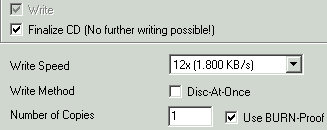 In
Nero 4.0.7.5 an option added in burn menu in order to activate or not
burn proof. When Burn-Proof activated you cannot simulation burn. You
can use Burn-Proof in both DAO and TAO mode. In
Nero 4.0.7.5 an option added in burn menu in order to activate or not
burn proof. When Burn-Proof activated you cannot simulation burn. You
can use Burn-Proof in both DAO and TAO mode.
|
|
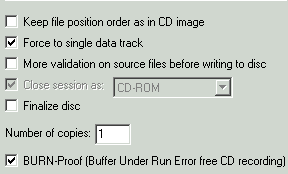 NTI
CD Maker Pro v3.7.880: NTI
CD Maker Pro v3.7.880:
 When
you open NTI CD Maker Pro it appears different logo from usual (BURN-Proof
enabled). In write menu similar to Nero it adds the BURN-Proof check
box which enables it. When
you open NTI CD Maker Pro it appears different logo from usual (BURN-Proof
enabled). In write menu similar to Nero it adds the BURN-Proof check
box which enables it.
|
|
 Padus
DiscJuggler v2.00.412 beta: Padus
DiscJuggler v2.00.412 beta:
The latest build of DiscJuggler is supposed to support
the Sanyo CRD-BP2 and the BURN-Proof feature. However, real tests proved
that even BURN-Proof option was enabled, it didn't worked :(.
We assume that this is due to the beta release and will be corrected
soon
|
|
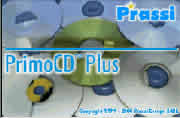 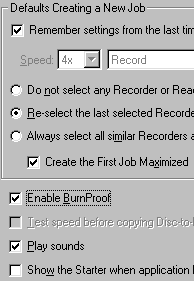 Prassi
PrimoCD Plus v1.1.356 Prassi
PrimoCD Plus v1.1.356
Latest update of Prassi PrimoCD Plus version adds BURN-Proof
feature. Our tests showed that it works very good as we expected. The
strange thing is that the advanced version of Prassi PrimoCD Plus (Pro
8) don't support BURN-Proof yet. So we were unable to test parallel
writing with BURN-Proof (enabled for Sanyo) and not for other CDR-W
drives. Let's hope Prassi will add soon BURN-Proof also to advanced
PrimoCD Pro 8 version.
|
Test Machine
ABIT BH6
Celeron 300A over clocked to 464 MHz
128 MB SDRAM PC 100
Quantum Fireball EX 6.4 GB UDMA
CL RivaTNT
CL AWE32
MS Windows 98 SE
DAWI 2974 PCI
Plextor UltraPlex PX-40TS, Firmware v1.03
Plextor UltraPlex PX-32TS, Firmware v1.03
Yamaha 8424s Firmware v1.0g
Plextor PleXWriter PX-124TS Firmware v1.02
KenWood 72x True-X Firmware v2.12e
Sanyo CRD-BP2 Firmware vBc12
3. Data Tests
Sanyo CRD-BP2
SCSI CDR-W - Page 3
Data
Tests
Test Method
We used CD WinBench 99 v1.1, CD Speed 99 v0.6 and SCSI Mechanic
v2.1h (evaluation version) to run the data tests with Sync Data Transfer enabled
on our SCSI controller. All tests (except the WinBench one) were done using
identical recordable media (Mitsui).
CD WinBench 99 v1.1 results
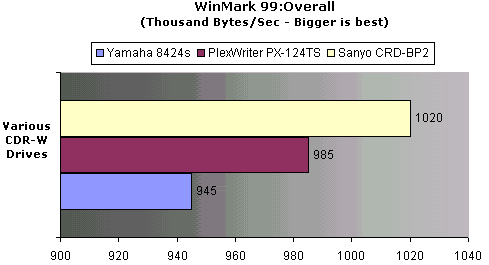
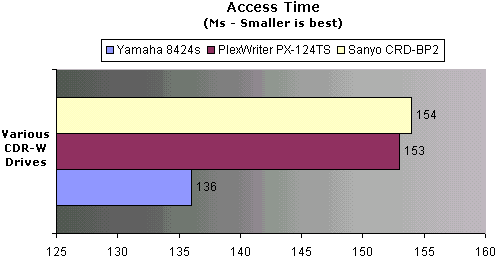
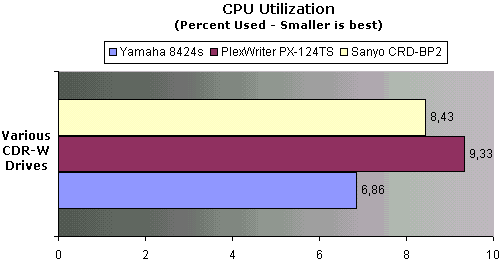
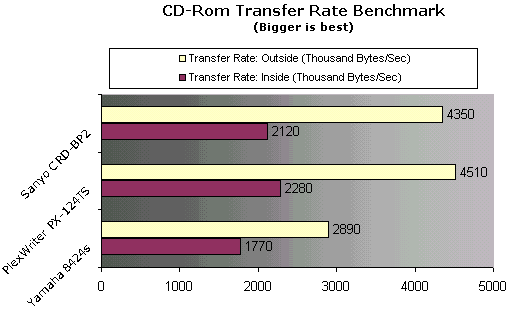
CD Speed results :
(Speed : Bigger is
better, Seek Times : less is better, CPU Usage : less is better)
|
|
Speed (x)
|
Seek Time (ms)
|
CPU Usage (%)
|
|
Start
|
Average
|
End
|
Random
|
1/3
|
Full
|
1x
|
2x
|
4x
|
8x
|
|
Sync Data Transfer On
|
14.37
|
24.69
|
32.63
|
176
|
147
|
274
|
1
|
3
|
7
|
13
|
SCSI Mechanic results
(I/O throughput :
Bigger is better)
|
|
Random I/O
throughput (kb/s)
|
Sequential I/O
throughput (kb/s)
|
Same Sector I/O
throughput (kb/s)
|
|
Min
|
Average
|
Max
|
Min
|
Average
|
Max
|
Min
|
Average
|
Max
|
|
Sync On
|
320
|
537
|
767
|
1332
|
3568
|
5136
|
742
|
1330
|
1448
|
Verdict of Data Tests
The Sanyo CRD-BP2 as a reader performs like an average 32 speed drive.
The average transfer rate is 3.5Mb/s and the maximum is 5.1MB/s. However, it's
seek time (176ms) is considered rather slow, which doesn't make it our number-one
pick for reading CDs with lots of small files. As for CPU usage, when reading
CDs it seems rather slow (for a SCSI device)---you have to enable the Sync Data
Transfer option on the host controller to make the drive work in it's maximum
speed.Sanyo CRD-BP2 is an average 32x CD Rom. Our opinion is that it shouldn't
be your first choice for reading since most current CD/DVD-ROM's are way faster.
4. DAE Tests
Sanyo CRD-BP2
SCSI CDR-W - Page 4
DAE Tests
CD Speed results:
(Speed : Bigger is
better, Seek Times : less is better, CPU Usage : less is better)
| |
Dae Quality/ Accurate Stream
|
Speed (x)
|
Seek Time (ms)
|
CPU Usage (%)
|
|
|
Start
|
Average
|
End
|
Random
|
1/3
|
Full
|
1x
|
2x
|
4x
|
8x
|
|
Sync On
|
10 - Yes
|
11.65
|
12.07
|
11.98
|
882
|
768
|
1127
|
15
|
18
|
23
|
34
|
Various Rippers Results
Test Method : We used the CDFS.VXD driver and EAC v0.9
pre beta 3 to test the audio capabilities. EAC reported that the drive was capable
of producing accurate stream and it also reported "caching off".
Tests were made for comparing "Burst" vs "Secure Stream
with caching" mode.
Tested CD: The Chemical Brothers "Dig
Your Own Hole" - Track : 1, 5, 11
Comparing Method:
- Ripped Tracks 1, 5, 10 of the CD with Drag & Drop (using CDFS) and
with EAC (Secure & Burst mode).
- Edited all wavs with Hedit v2.0.04 and located the 2 following bytes (chosen
randomly)
- Removed all previous bytes and saved.
- Then in a Dos window compared them using: FC /b x.wav y.wav
Programs Settings:
CDFS Driver v4.00.130 :
Drag & Drop
EAC v0.9b : Burst
& Secure Mode / Rip Speed Default / Allow speed reduction / Error correction
medium
|
Program
|
Average Speed / CPU Usage
|
Listening Quality
|
|
1 Track
|
5 Track
|
11 Track
|
|
CDFS Driver v4.00.130
|
25sec = 11.52x / 7%
|
28sec = 11.40x / 7%
|
27sec = 10.80x / 5.2%
|
No clicks..No sec lost..Seemed ok!
|
|
EAC v0.9b (burst)
|
11.2x / 22%
|
12.2x /25%
|
12.3x / 26%
|
No clicks..No sec lost..Seemed ok!
|
|
EAC v0.9b (secure)
|
2.8x / 6.6%
|
2.9x / 6.7%
|
3.1x / 7.1%
|
No clicks..No sec lost..Seemed ok!
|
|
Comparing Results
|
|
|
CDFS Driver v4.00.130
|
EAC v0.9 (burst)
|
|
1 Track
|
5 Track
|
10 Track
|
1 Track
|
5 Track
|
10 Track
|
|
EAC v0.9b (secure)
|
same
|
same
|
same
|
same
|
not same
|
not same
|
Verdict of DAE Results
Sanyo CRD-BP2 has problems with DAE performance. It seems that when it rips
at speeds higher than 12x, it returns errors. At speeds lower than 12x , the
drive gives accurate WAV files. However, this can be easily fixed with
the release of a future firmware update. Please remember that this is a pre-release
drive. Other manufactures which will soon release other BURN-Proof based drives
will most probably correct those errors or even make their drives perform better!
However, personally, we never use a CDR-W for ripping, so we don't think poor
DAE performance is a problem!
5. CDR Tests
Sanyo
CRD-BP2 SCSI
CDR-W - Page 5
CDR Tests
We mostly tested Sanyo CRD-Bp2 on it's capabilities to write
12x CDs with the BURN-Proof feature enabled. (Since this is the feature we
all expected to see how it works.)
Software used :
Nero v4.0.7.5 / NTI CD MAKER Pro v3.6.870
Brand Of CDs :
Prodisc / Prostech / Ritek / Princo 8x, 12x / Basf / Maxell / Mitsui Gold
& SG / TDK / Verbatim / Yamaha 4x RW / LeadData 4x RW / BTC 2x RW
CDR Tests :
On the Fly CD Copy (both Data and Audio) (with Plextor PX-40TS/Pioneer
DR-104S)
Data CDs (Multisession - TAO,DAO,SAO)
AudioCDs (from mp3 and wav files) + CD-Text CDs
VideoCD
BURN-Proof Tests:
When we first read about BURN-Proof we thought ..nah.. this can't be possible.
We can make our PC's buffer underrun whenever we want. So when we got Sanyo
CRD-BP2 at our hands our first concern was to test the so called "BURN-Proof"
capability. What did we do?
We tried to burn at 12x and at the same time run
the following programs:
- Winamp with Visual OpenGL plug-in
- Prassi PrimoCD doing 2 images from 2 CD ROM's into same HD
- AVP checking for virus same HD
- Scandisk of Windows checking same disk
- CheckCD98 of WinOnCD measuring same HD
- Several IE and NS windows open
- Sisoft Sanda Benchmarking PC same time all above programs running
Running all of the above programs simultaneously, almost succeeded
bringing my PC into its knees, crash (CPU LOAD 100%) but no bad burn! Want
more tests?
How about writing CDs in 12x from Disk Drives and no coaster?
How about while writing CDs pressing Ctrl+Alt+Del, leave the PC at this condition
for 5 minutes and then come back continue burning and not a single coaster?
Is this impressive or not ? All our projects causing buffer underrun (and
coasters) with BURN-Proof feature turned on failed:(
However this showed that BURN-Proof technology really works great and future
CDR-W based on this technology will make you all happy. You will be able to
work and at the same time burn your favourite CDs without caring for destroying
the media. This is something no one was able to do in the past.
6. Conclusion
Sanyo CRD-BP2
SCSI CDR-W - Page 6
Conclusion
|
Positive (+)
|
Negative (-)
|
|
- Burn Proof (anti-coaster) Technology!
- 12x Writing
- CD-Text
- Support most burn speeds (1x,2x,4x,8x,12x)
- Supports (2x,4x) CD-RW burn speed
- True 32x (max) Data performance
- All know burning method (TAO,DAO,SAO,Packet Writing) support
- No problems with uncertified 12x Media
|
- No MMC DAO Raw read/writting (coming
soon..)
- No Overburn
- Did not read correctly overburned 74min AudioCDs (up to 77min) and not
proper closed CDs
- Not so good DAE performance
|
Overall Sanyo CRD-BP2 seems a fantastic drive. Not only
it supports 12x writing but also includes BURN-Proof technology to eliminate
Buffer underruns. As you might already have read, the technology works OK in
almost all cases. It can really help you working onto your PC's as usual and
at the same time write CDs even at 12x and all this without a single worriness.
So, are all features of this drive are OK? The drive misses the
ability to Overburn and the MMC RAW feature. Also, the drive's Data and DAE
performance are not so great. Further it has problems reading not-so-perfectly
written Data and Audio CDs. Possibly, these bad points will be corrected with
future firmware updates. Remember this drive isn't released yet, so further
tuning is possible and will be surely available at the production units.
Update: As we learned MMC DAO RAW will be added in next
revision of firmware. Also possibly BAD DAE performance will be corrected.
Even without these features, most CDR-W users which buy a BURN-Proof
capable drive will love it and will never deal again with buffer underruns.
Lacie already announced a BURN-Proof capable drive starting selling it in US
during March 2000.
7. Mini-FAQ
Sanyo CRD-BP2
SCSI CDR-W - Page 7
Mini-FAQ
Is Sanyo CRD-BP2 any good?
Sanyo CRD-BP2 (And all Burn-proof compatible drives that will emerge) marks
the next generation in Cd-recording technology. It's more than good, it's epic.
Is this as good as a cd-recorder will ever be, or is there
more to come?
Hmm. You should expect the IDE drives with Burn Proof in Q2 2000 and possibly
CDR-W drives with 8x rewriting (from Sanyo and other manufacturers). Also, a
newer version of burn-proof maybe (or a variation from another manufacturer)
with more capabilities, e.g. the ability to continue burning a disc after a
reboot or system crash, and of course, the red-book compatibility issues.
When will CRD-BP2 drives hit the streets?
Never! Sanyo is O.E.M in CDR business; they will sell the licence to other
cd-r makers that will manufacture compatible cd-r drives.
Ok. From what manufactures should I expect 12x CDR-W drives
with Burn Proof feature?
Lacie already announced it. We imagine lot of companies will sell CDR-W
drives with burn proof as: Plextor, Imation and others.
What about prices?
Nothing has yet been announced, but expect slightly higher prices than regular
burners.
Can I upgrade my current 8x, 12x drive so it supports Burn-Proof
feature?
Current 12X CDR drives (like Plextor PX-124TS, Sanyo CRD-RW2) will not be
upgradeable to Burn-Proof by firmware update due to the hardware difference,
mainly LSI. BURN-Proof feature consists of LSI and firmware.
Will there be firmware upgrades that include MMC DAO RAW and
Overburn Features?
Yes. Sanyo is working on some more features and we hope they will add them
soon.
Will Burn Proof give me 100% protection from coasters?
Burn-proof prevents buffer-underruns. But coasters WILL occur when the system
crashes, hangs, or reboots, or we have a mechanical failure, or bad cd-media.
Where does BURN-Proof name come from?
From Buffer Under Run-Proof.
Sanyo signed a deal with Zen Research about the use of TrueX
technology. What should i expect from this co-operation?
No comment ;)
8. ADDENDUM
Sanyo CRD-BP2
SCSI CDR-W - Page 8
ADDENDUM
A
suggestion to the SANYO engineers
Our current understanding of CDR technology suggests (at least
to some of us) that the BURN-Proof feature can be enhanced in the following
scenario not currently supported. If an operating system or other software
related crash occurs, the drive should be able to store the last EFM address
recorded on special non-volatile RAM by making use a specifically designed
on-drive FIFO. Additionally, a special "signature" of both the recording
application and the last to-be-recorded disk should be stored on both this
RAM and a "special" area on the disk. After reboot, with the last
"coaster" disk still inserted, the recording application should
be able to inquire the drive and derive the exact location on the disk (MSF)
where the recording error occurred.
Under a predefined protocol, which both the drive and the recording
software are able to understand, recording should be able to continue even
if an error of such a severity ever takes place! All this can be handled through
some proprietary extensions to the MMC-2 specifications and requires an agreement
on the type of "hash" used to describe each recording application
(name, version, etc) and the type and some other specifics of the image disk.
If all this is possible, then CDR technology will be so much BURN-Proof as
hard disk writing currently is ;)
So unless a system crash renders a user's PC inopperable, BURN-Proof
technology should be able to protect his drive from any other buffer underrun
error of less severity:)